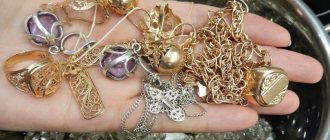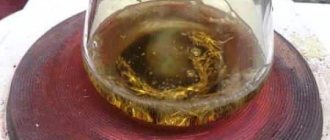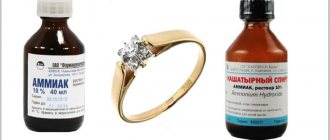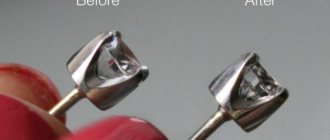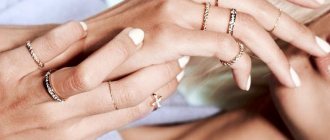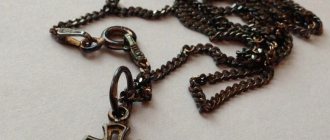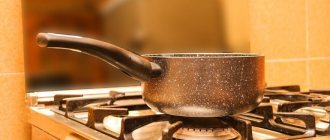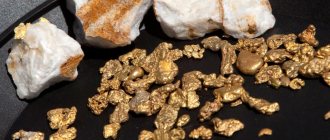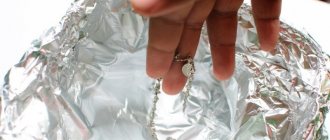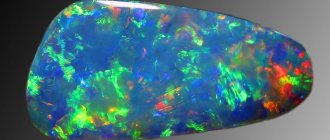Good afternoon, reader!
In today's episode we'll talk about how to give jewelry its original look. Namely, how to clean gold with hydrogen peroxide yourself.
Gold is a noble metal of yellow color, soft, but heavy due to its high density. Due to its thermodynamic properties, it is used in the creation of jewelry. The high plasticity of gold allows you to create openwork patterns; the metal is drawn into the thinnest wire.
Improved physical properties are achieved in an alloy that contains other alloying elements: copper, nickel, cobalt, zinc, silver, palladium. Gold is responsible for corrosion resistance, beauty and elegance. Impurities give characteristic shades from pink to green, copper - red.
Causes of gold contamination
Pure gold does not oxidize. In jewelry it is used only as an alloy with other metals. This way the product becomes much stronger mechanically, but more vulnerable and unstable to alkalis and acids.
The aggressive environment of household chemicals, cosmetics, dust, sweat - this is a list of possible polluters. Under the influence of these natural reagents, gold items become dull and lose their shining original appearance, and darkening appears in some places. Scratches are possible during wear.
In the workshop, the jeweler will professionally clean the item and present a polished piece without scratches. But what should those who do not have such a master and extra funds for jewelry services do?
Let's reveal the secret. There are a number of products available at home, thanks to which you can clean yourself, ridding gold items of dirt and plaque. One of them is hydrogen peroxide.
Methods for purifying gold
The method used for cleaning should be chosen based, first of all, on the characteristics of the treasure itself: the alloy from which it is made, the presence of a coating, whether it has a matte or glossy surface, whether it has inserts.
There are several options for returning the yellow metal to its former glory.
- Taking it to a jewelry workshop is the least labor-intensive, but at the same time expensive option. Regularly processing large quantities of items can cost a pretty penny. However, if the earrings or ring are very expensive, fragile, or you are not sure that you know their composition, then it is still better not to take risks and entrust the matter to a master.
- Buy a professional product - they are presented in a large assortment in jewelry stores, you can also look in the departments of household chemicals. Their forms are different: creams, pastes, sprays, wet wipes. You should be more careful when purchasing, since there are often situations when a product is suitable for one type of jewelry, but is strictly contraindicated for another.
- Buying an ultrasonic cleaner is an expensive purchase, but you will only have to spend money once, unlike going to a specialist or buying special products. Please note that not all products can be cleaned this way. Some stones cannot withstand exposure to ultrasound and may crack.
- Using improvised means is the cheapest way. Additionally, most of the ingredients for these mixtures can be found at home. Among the disadvantages, it would be fair to note that the result is not always predictable: you often have to act at your own peril and risk. No one can guarantee how the metal will behave under such procedures, so you should approach the choice of recipe with caution.
Under no circumstances should you wash gold and silver valuables in the same solution. Otherwise, they will become covered with a white coating that is difficult to remove. To clean silver jewelry from blackness and other dirt, take a separate bowl.
Is it possible to clean gold with hydrogen peroxide?
You can clean gold at home using different methods. The king of home cleaning products is hydrogen peroxide. When choosing this method, you should know: peroxide is almost always used in combination with an ammonia solution (ammonia) or soap solution.
Mechanism of action of antiseptic
The mechanism of action of the cleaning solution is the interaction of hydrogen peroxide with an ammonia solution, during which a chemical reaction with the formation of peroxide causes an antiseptic property, removing dust, dirt, sweat and other bactericidal microflora. The product regains its shine and clean, even shade.
Cleaning jewelry with stones
Gold jewelry with stones requires special care. For example, if a pebble is set on glue, then it cannot be immersed in liquid, otherwise the adhesive substance will dissolve. In addition, some inlays simply cannot withstand mechanical stress.
What to do? How to clean gold with stones? It all depends on the type of gem.
- Zircons, diamonds, topazes, emerald stones, garnet products, and blue sapphires belong to the group of hard stones. That is, they can be cleaned in almost any way, without forgetting, however, about the type of fastening.
- Coral, pearl, turquoise and opal jewelry fall under the category of soft stones. When cleaning them, do not use brushes or abrasive materials (dry salt and soda). Excess moisture is also contraindicated for them. You should also avoid acids – citric and acetic.
It remains to understand what compositions and methods are allowed and acceptable. The simplest and most universal method is to use a warm soap solution. And to remove old plaque, hard stones can be rubbed with a soft toothbrush, and soft gems with a felt cloth.
How to clean gold and diamonds? Try the option with ammonia and shampoo, which we wrote about at the very beginning of the article. Just don't put jewelry in undiluted ammonia. To get rid of greasy deposits, diamonds and emeralds can be wiped with felt soaked in gasoline.
Advantages and disadvantages of peroxide
The advantages of this method are the availability, low cost of hydrogen peroxide and other products used with it, and a minimum of time spent. Both drugs are available without a prescription in pharmacies. Cleaning time is minimal. Before a dinner party, theatrical performance or other celebration, it is enough to dilute these two components with water and after 15-20 minutes, while you are getting dressed, the jewelry will shine like new.
The disadvantage of this cleaning method is the lack of versatility. The fact is that this method is unacceptable if there are precious stones in the jewelry. This type of cleaning medium is not suitable for them due to its aggressiveness.
Processing gilding
When choosing what and how to clean items made of gold-plated silver, you need to take into account the characteristics of this material.
This coating is thin, which does not require the use of aggressive cleaning methods. In addition, it is also not recommended to use a hard toothbrush or sharp objects.
If gold plating loses its shine or develops blackness on its surface, experts recommend treating the surface with a solution containing alcohol (vodka, cologne). You need to wipe it without much physical effort. This may cause the gold plating to wear off.
In the absence of alcohol-containing products, it is possible to use turpentine or vinegar to clean gold-plated items (they must first be diluted in water).
After treating the surface of the gold plated coating with alcohol, you can wipe the surface with wine vinegar. To do this, water is mixed with 2 tbsp. alcohol and diluted in 25 grams of soap shavings. Add 6-7 drops of ammonia to the solution.
You can also achieve a positive result when cleaning gilding by using a bleach solution (1 tablespoon diluted in 1 liter of water).
Which samples can withstand this treatment?
This cleaning method is suitable for all precious metal samples.
Important: The product sample indicates the gold content in the alloy and is controlled at the state level. The higher the standard of gold jewelry, the higher its vulnerability to damage.
5 samples are considered generally accepted in Russia:
- 375 (Au 38%)
- 500 (50.5% gold)
- 585 (58,5%)
- 750 (75,5%)
- 958 (96,6%)
999 - pure gold, hallmark for bullion. In the country's jewelry industry, there are products of 583, 900 and 916 samples, as evidenced by the stamp on the gold jewelry.
Prevention
To make rings, bracelets, earrings and chains sparkle and delight you with their appearance, you need to adhere to simple operating rules.
- Remove jewelry before dirty work, contact with household chemicals, sports and cosmetic procedures.
- If moisture gets on the gold, be sure to wipe it with a cloth.
- Clean your accessories at least once every 2 months.
- It is better to store jewelry away from sunlight in a wooden box with soft walls.
How not to clean gold
There are many proven ways to clean gold at home. Although their effectiveness has been proven in practice, there are contraindications.
When delicately cleaning gold items with precious stones, you should refrain from using aggressive reagents. They cannot be cleaned with acids, including vinegar. Subject to mechanical impact with abrasive materials or a rough brush. Products inlaid with stones are afraid of water. Turquoise and coral do not tolerate alcohol. White gold reacts negatively to powder and toothpaste.
Daily care of gold
Factors that contribute to the darkening of gold include:
- Sun rays;
- contacts with aggressive household chemicals;
- prolonged contact with moisture, especially sweat;
- Iodine is an extremely dangerous substance for gold, so avoid any contact of your jewelry with it. Once iodine gets on the surface of the jewelry, the gold darkens, and it is extremely difficult to get rid of this stain;
- mechanical damage (impacts, scratches).
Gold jewelry will last much longer if
you do not forget about the rules of wearing it. To avoid having to regularly and thoroughly clean your jewelry, you need to pay attention to storing, wearing and protecting it from harmful influences. Not worth it:
- wear jewelry in the bathhouse, sauna, gym;
- leave them on the windowsill on a clear sunny day;
- wear jewelry while cleaning the house or working in the garden;
- take gold items to the beach and also to the pool;
- leave jewelry on yourself during skin care procedures (applying cream, washing, peeling, etc.);
- wear gold during heavy physical work (for example, in a factory, where there is a risk of knocking or scratching the product).
Cleaning Solution Recipes
Try to clean gold with the simplest and most commonly available household products: soda and salt. From them, cleaning solutions based on hydrogen peroxide are prepared, which cope with light stains. Sometimes sugar is also added there.
Peroxide with soda
To clean, you need to do a number of well-established steps:
- In 200 ml. water, add 2 tablespoons of baking soda and the same amount of 3% hydrogen peroxide.
- Place the decorations on the foil-lined bottom of the container you are using overnight.
- Upon completion of the process, remove, rinse, dry, rub with a napkin until shiny.
- A colorless lipstick will give a polishing effect.
Important: it is recommended to use a non-metallic container (glass, ceramic) for cleaning reagents.
With salt
A simple solution for cleaning precious metals, called express cleaning, is salt water.
The manipulations are really simple: dilute three tablespoons of salt in a glass of warm water. Immerse the gold jewelry and leave it overnight; In the morning, rinse and dry, polish with felt, velor or velvet. That's all. Your jewelry will shine again, shining with purity and nobility.
Table vinegar
This method is suitable for cleaning gold jewelry made of yellow and red gold without any inserts.
Note! It is not recommended to clean white gold with vinegar.
- Make a vinegar solution. To do this, mix 1 part water with 1 part 9% table vinegar.
- Immerse the product in the solution for 5-10 minutes.
- Remove the jewelry and rinse it under the tap with warm water.
- Dry and wipe the product with a microfiber, felt or flannel cloth until it shines.
What's the best way to clean very dirty gold?
If the jewelry is very dirty and the previous 2 methods did not help you, then it would be best to use the following solution with hydrogen peroxide.
Preparing Jewelry for Cleaning
Take off your gold jewelry and sort it into categories:
- separate pendants with stones from the chain;
- rings with diamonds or other precious stones;
- set white gold aside from yellow gold.
This sorting is necessary because what is suitable for one subgroup is not suitable for another and vice versa.
The importance of following the recipe exactly during the cleaning process
The favorable outcome of the procedure undertaken entirely depends on pre-thought-out actions - this includes the choice of container for cleaning, the preparation of cleaning products (solution, sticks, brushes, napkins) - everything is prepared in advance and is at hand.
Observe the time of immersion in the solution, do not overexpose it - a moment that cannot be neglected.
Peroxide + ammonia
Let's consider the cleaning algorithm:
- Take a glass (not metal!) of clean, boiled, warm water.
- Pour 2 teaspoons of ammonia and 2 tablespoons of 3% hydrogen peroxide into it.
- Thoroughly stir the contents of the glass and immerse the jewelry for 15-20 minutes.
- Rinse cleaned products thoroughly.
- Dry with a soft, clean cloth.
- Polish with a cloth (velor will do).
By the way, you can try to do without ammonia by replacing ammonia with dishwashing detergent in the amount of 1 teaspoon.
Features of cleaning different types of gold and jewelry
Some types of jewelry require delicate treatment, and therefore their cleaning must be approached with special attention.
White gold
White gold differs from ordinary gold in its noble shade, which is obtained by adding silver, nickel or palladium to the alloy. Such jewelry has a delicate coating, and therefore harsh cleaning methods are contraindicated for them.
White gold looks especially stylish if it is properly cared for and gently cleaned.
You can clean white gold with such a gentle product as a mixture of ammonia (1 part) and hydrogen peroxide (2 parts). Place the jewelry in a container with this liquid for 30–60 minutes, then rinse with running water and wipe dry.
A sugar solution will help get rid of plaque on white gold. Place two tablespoons of sugar in one glass of warm water and stir thoroughly. The decoration must be left in this solution for 12 hours.
Learn how to bleach items made from another precious metal, silver, from our article - Effective ways to clean silver.
Matte gold
Matte gold jewelry cannot be polished with special means. It is not difficult to guess that they are also not subject to mechanical cleaning - all the beauty of the matte smooth coating will be instantly spoiled by many scratches. To clean such a product from plaque, just soak it in an ammonia solution (25%) for 30–40 minutes, then rinse with running water and wipe dry, wiping off the remaining plaque with a rag.
Matte gold jewelry is refined and elegant, and also requires particularly careful cleaning
Gold plated jewelry
Gold-plated metals have a very thin coating that easily oxidizes and ages. Never use materials with abrasive particles to clean such items, as they will easily scratch the gold layer. To preserve the original appearance of your jewelry, you need to:
- Use wine alcohol for cleaning. Soak a cotton pad in it and gently wipe the product, then rinse the alcohol off the gold plate under the tap;
- soak the jewelry for 30 minutes in light beer, then rinse the jewelry in running water and wipe dry;
- Wipe your jewelry regularly with a jewelry care cloth.
Gold-plated products have the same attractive appearance as gold, but have a lower price
Jewelry with stones
If the jewelry is decorated with precious inserts, it requires especially careful cleaning. Do not use any abrasive products (pastes or any other preparations with small hard particles, such as tooth powder) on such jewelry, and also refuse mechanical cleaning so as not to damage the stone. Never clean jewelry with the following stones with chemicals or folk remedies:
- turquoise. Jewelry with this insert should not be exposed to prolonged contact with water, as the stone will lose its original color and may become dull and uneven in color. Turquoise also reacts to chemical treatment, losing its attractive appearance;
- coral, pearls, mother-of-pearl. These materials have a very delicate surface that is easily scratched and comes into contact with various chemicals used to clean gold jewelry;
- opal When treated with folk or special preparations for purifying gold, the unusual color of opal can acquire an undesirable grayish tint and lose its depth and purity.
Pearls, like some other inserts, are extremely sensitive to chemicals and require more careful cleaning.
How to clean such jewelry? Use a damp cloth to wipe away any remaining sweat, residue and grease, then immediately wipe the item with a dry microfiber or a special gold polishing cloth.
gold chain
A gold chain without any inserts can be cleaned with slightly more aggressive means than jewelry with precious stones. One of the most accessible methods is a mixture of ammonia, hydrogen peroxide, washing powder and warm water:
- Mix a teaspoon of ammonia (ammonia), three teaspoons of hydrogen peroxide, and a pinch of washing powder in a glass of warm water.
- Place the chain in the resulting mixture for half an hour.
- During soaking, periodically shake the mixture and turn the product over.
- Rinse the chain under the tap to remove any remaining product.
After cleaning with these improvised means, the gold chain will shine and delight you with its appearance.
Other cleaning methods
If the above recipes with peroxide helped, but hard-to-reach places in the form of openwork weaves of precious metal remain untouched, then mechanical work cannot be done without.
Mechanical
For hard-to-reach places on jewelry, mechanical cleaning is used. The surest way is to use toothpicks, which you will have to dip in the cleaning solution. If necessary, wrap a small cotton swab around the tip of the toothpick.
The most effective thing here is not hydrogen peroxide, but a universal paste, which includes laundry soap, chalk, petroleum jelly, and tooth powder. These components are mixed with water until smooth. Apply a thick mixture to the product with a soft cloth and wipe off. The final stages of cleaning are standard washing and drying. In this way complete triumph is achieved.
Toothpaste
Take toothpaste without any additives. Avoid using bleach paste as it contains abrasive particles that can scratch the metal. The optimal choice is colorless gel.
- Apply the paste to a cloth.
- Rub the product with a napkin using soft circular movements.
- Rinse the decoration from the paste under running water.
- Wipe the gold item dry and then wipe with a microfiber, felt or flannel cloth until it shines.
Rules for wearing, caring for and storing gold jewelry
Delicate care of precious metal products will extend their service life. You should wear gold items carefully, do not expose them to mechanical stress, remove jewelry at night, periodically clean it, and store it in a special wooden case or box.
We hope that our recipes with hydrogen peroxide have helped you and brought additional knowledge to your treasury of worldly wisdom. In order not to miss all the most important things, subscribe to our articles. Don't forget to share useful information on social networks with your friends. See you soon!
Why does gold darken?
When purchasing products made from such a noble material as gold, you should pay attention to the sample of the jewelry. Since gold is a soft material, various alloys are added to products, most often copper. Therefore, jewelry of 585 standard will become unpresentable much earlier than a product of 750 standard. This is explained by the fact that in jewelry of low standard, the percentage of gold content is less, this applies specifically to 585 standard.
Besides the scientific point of view, there is another explanation why gold darkens. It is popularly believed that jewelry made of gold or silver reflects the state of the human body. If the jewelry darkens, it means there are health problems. But this has not been proven, which means there is no need to adhere to this point of view.
Cleaning gold is important, because it is not only a matter of aesthetic appearance, but also the condition of the products. The longer they remain darkened, the more they deteriorate. But you also need to clean them carefully.
Additional cleaning tools and helpful tips
- After cleaning the gold, you can rub it with a toothbrush. This should be done before the decoration is dried and wiped dry. Jewelry can be left in the solution and cleaned in water. This will remove dirt on jewelry with many small parts.
- For more effective cleaning, you can stir the gold in a container. This is done manually or using mechanisms. On the Internet you can find instructions for assembling a special washing container with a motor that will vibrate and agitate the contents of the container.
- To make it easier to remove gold items from the container, they should be strung on something. Then you won’t have to catch them in hot water and wait until they cool down.
- After drying the gold, it should be rubbed with a coarse-pile cloth. This will finally remove the solution from the surface and further polish it.
Cleaning gold with baking soda is very easy. But we must remember that if the technology is violated and the presence of foreign substances in the solution is allowed, the result may be negative. It is also easy to damage the surface of the jewelry by improper cleaning. Following precautions will allow you to obtain shiny gold that will look like new, will delight the owner and delight others.
